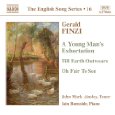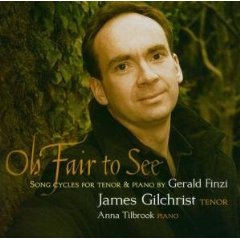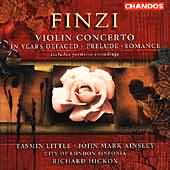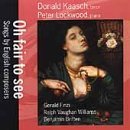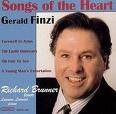In years defaced
- Musical Analysis Section
- Audio Recordings Section
- Unpublished Analysis Excerpts
- Gerhardus Daniël Van der Watt - The Songs of Gerald Finzi (1901-1956) To Poems by Thomas Hardy
- Mark Carlisle - Gerald Finzi: A performance Analysis of A Young Man's Exhortation and Till Earth Outwears, Two Works for High Voice and
- Leslie Alan Denning - A Discussion and Analysis of Songs for the Tenor Voice Composed by Gerald Finzi with Texts by Thomas Hardy
Poet: Thomas Hardy
Date of poem: (undated)
Publication date: In the collection: Poems of the Past and the Present (1902)
Publisher: Macmillan Publishing Company
Collection: Poems of the Past and the Present (1902) under the heading "Miscellaneous Poems."
History of Poem: Thomas Hardy writes in the "Preface" before Poems of the Past and the Present: "Of the subject-matter of this volume even that which is in other than narrative form - much is dramatic or impersonative even where not explicitly so. Moreover, that portion which may be regarded as individual comprises a series of feelings and fancies written down in widely differing moods and circumstances, and at various dates. It will probably be found, therefore, to possess little cohesion of thought or harmony of colouring. I do not greatly regret this. Unadjusted impressions have their value, and the road to a true philosophy of life seems to lie in humbly recording diverse readings of its phenomena as they are forced upon us by change and change. August 1901" (Hardy, 84)
James Osler Bailey writes: "Russell Boughton, in his operatic version of Hardy's The Queen of Cornwall, with Hardy's approval omitted the epilogue and substituted "A Spot," sung by a chorus of Shades at the end of the opera." (Roberts, 100) as quoted by (Bailey, 159)
Poem
A Spot |
||
|---|---|---|
| 1 | IN years defaced and lost, | a |
| 2 | Two sat here, transport-tossed, | a |
| 3 | Lit by a living love | b |
| 4 | The wilted world knew nothing of: | b |
| 5 | Scared momently | c |
| 6 | By gaingivings, | d |
| 7 | Then hoping things | d |
| 8 | That could not be . . . | c |
| 9 | Of love and us no trace | e |
| 10 | Abides upon the place; | e |
| 11 | The sun and shadows wheel, | f |
| 12 | Season and season sereward steal; | f |
| 13 | Foul days and fair | g |
| 14 | Here, too, prevail, | h |
| 15 | And gust and gale | h |
| 16 | As everywhere. | g |
| 17 | But lonely shepherd souls | i |
| 18 | Who bask amid these knolls | i |
| 19 | May catch a faery sound | j |
| 20 | On sleepy noontides from the ground: | j |
| 21 | ‘O not again | k |
| 22 | Till Earth outwears | l |
| 23 | Shall love like theirs | l |
| 24 | Suffuse this glen!’ | k |
(Hardy, 139-40) |
||
Content/Meaning of the Poem:
1st stanza: Years forgotten, long ago, two sat here deeply in love and yet the world knew them not: they feared their love and love would disappear because it was not meant to be.
2nd stanza: There is not a trace that remains of their love in this place; the years and seasons go by obscuring their love and yet nature cares not.
3rd stanza: But there is still glimpses of their love heard occasionally by the shepherds lying on the hillsides in the noon day sun: their love will not fill this valley or return until the Earth is no more.
For additional comments as to possible meaning of the text please refer to: Content - Van der Watt.
Speaker: The poet himself, Thomas Hardy.
In James Osler Bailey's book The Poetry of Thomas Hardy he quotes from Lois Deacon's book, Hardy's Sweetest Image with regards to characters that "Hardy and Tryphena Sparks may be the lovers within the poem." (Bailey, 158)
Setting: James Osler Bailey places the setting of the poem in a sheep pasture by the name of Coombe Eweleaze which is near Puddletown. (Bailey, 158)
Mark Carlisle makes the same suggestion as Bailey in his dissertation with some specific directions on how to find the pasture. "The 'spot' that provides the setting for this poem is generally thought to be a sheep pasture called Coombe Eweleaze near Puddletown, less than two miles from Hardy's boyhood home. It was a favorite spot for village festivities, and no doubt a place where Thomas and Tryphena spent much time together." (Carlisle, 38)
Purpose: Hardy reminds us that we only have the present; no matter how strong we loved someone or how successful we are, it will, eventually, be forgotten.
Idea or theme: We only have today, memories fade and eventually disappear altogether.
Style: Hardy uses a pastoral lyrical style. For additional comments please refer to: Style - Van der Watt.
Form: James Osler Bailey records in his book, The Poetry of Thomas Hardy the following: "[Samuel] Hynes has identified the verse-form [in his book - The Pattern of Hardy's Poetry, p. 87] as drawn from Nahum Tate's and Nicholas Brady's A New Version of the Psalms of David, where "Psalm 148 is written in stanzas of eight lines, four three-stressed lines followed by four two-stressed lines, rhyming ababcddc" - though Hardy varies the pattern somewhat."
(Bailey, 158)
Gerhardus Daniël Van der Watt writes in his dissertation as to the form, "The poem has three stanzas, each in turn consisting of eight lines of uneven length. The fourth line of each stanza is significantly longer and is isolated by being placed left of the normal stanza position. Lines 5-8 of each stanza are shorter than the rest. There seems to be no direct relation between this particular formal structure and the content of the poem. Hardy did experiment with form for the sake of form, the longer line being emphasized visually. The rhyme scheme is a mixture of paired and rounded rhyme: aabbcddc eeffghhg iijjkllk. The metre is largely iambic although there are a number of trochaic inversions (1, 2, 3, 12, 13, 14 and 21)." (Van der Watt, 368)
Synthesis: The three stanzas of the poem chronicle the lives of two lovers gone and most probably forgotten at least from Hardy's perspective. In a typical Hardy fashion he chooses to write lyrics that remind one to live life full with no regrets but as was the case with his poem "Let me enjoy the earth" he weaves a thread of hope that there may be something more after one dies. In the case of this poem, "A Spot" it takes the shape of a sound that "shepherds" may hear but in "Let me enjoy the earth" he considers heaven even though he says "Though it contain no place for me." Obviously life after death is something that plagued Hardy. Possibly it was a deep fear of his that he would be forgotten. In his poem, "Her Temple" he ends with "None now knows his name" referring to himself. At some point in Hardy's adult life he lost his faith in God and perhaps by writing poems that dispelled the belief in God he hoped to find his faith once again. His first wife, Emma had strong religious beliefs and was angered when Hardy would write immoral stories and this may have added to the chasm that came between them but as to whether or not Hardy composed the agnostic lyrics hoping to find faith is unclear but if it proved true it would be exceptionally ironic.
Gerhardus Daniël Van der Watt, in his dissertation, offers the following with regards to the poem, "A Spot": "The poem's actual narrative is quite obscure. No information is given about the individuals or the circumstances which give rise to them being in the particular spot. The vagueness seems to be deliberate to focus the reader's attention on the main aim of the poem: to bring a tribute to the lover's unfailing love. The situation does, however, remind one of the closing section of Tess of the D'Urbervilles, when Tess and Angel Clare are together for the last time before she is arrested."
(Van der Watt, 368)
Mark Carlisle writes in his dissertation the following comments about "A Spot": "The poem is certainly one of the more engaging Hardy ever wrote. It depicts for the readier a scene "among the knolls" where once existed an unknown, but very real and passionate love between two people. This love, as strong as it was, could not survive the circumstances of the time, and became only a quiet and solitary memory in the passing of seasons and years. However, for those "lonely shepherd souls" who peacefully spend time in the knolls, they may hear those magical words, "O not again, till earth outwears, shall love like theirs suffuse this glen." It is deeply felt expression of lost love that has been enlivened even more through the power of music."
(Carlisle, 38-9)
Published comments: James Osler Bailey writes: "[Ruth A.] Firor points out that the poem makes use of the folk-belief in the power of shepherds to perceive emanations from a place that was the scene of strong emotional disturbance." (Firor, 70) as quoted by (Bailey, 158)
✦✼✦✼✦✼✦✼✦✼✦✼✦✼✦✼✦✼✦✼✦✼✦✼✦✼✦✼✦✼✦✼✦✼✦
Poems of the Past and the Present
- Collection of 99 poems written by Thomas Hardy.
- Published in November of 1901 by Harper and Brothers.
- Hardy's second collection of poems published.
"An anonymous reviewer of the volume for the Saturday Review called it a "grey book," but declared that every poem in the book had "something to say," even though it was sometimes said in a "slow, twisted, sometimes enigmatic manner." (Wright, 251)
"T. H. Warren, president of Magdalen College, Oxford, writing in The Spectator, suggested that poetry was not Hardy's "proper medium," and deplored his "morbid taste for the ghastly and the gruesome." (Wright, 251)
Gerald Finzi set the following poems within this collection:
- A Spot [titled by Finzi as: In Years Defaced] (Till Earth Outwears)
- At a Lunar Eclipse (Till Earth Outwears)
- The Comet at Yell'ham (A Young Man's Exhortation)
- I Need Not Go (I Said To Love)
- In Years Defaced (Till Earth Outwears)
- I Said to Love (I Said To Love)
- To Lizbie Browne (Earth and Air and Rain)
- The Self-Unseeing (Before and After Summer)
Helpful Links:
- Thomas Hardy Web site
- Project Gutenberg (e-text format of all poems within collection)
- Fullbooks.com (texts for all poems within collection)
✦✼✦✼✦✼✦✼✦✼✦✼✦✼✦✼✦✼✦✼✦✼✦✼✦✼✦✼✦✼✦✼✦✼✦
Musical Analysis
Composition date: 1936
Publication date: © Copyright © 1958 by Boosey & Co. Ltd.
Publisher: Boosey & Hawkes - distributed by Hal Leonard Corporation
Tonality: The song begins and ends in D minor but there are frequent modulations to F major according to Gerhardus Daniël Van der Watt. Mark Carlisle, on the other hand, suggests that because Finzi chose C-natural over C-sharp at times that perhaps "the Aeolian mode is the actual harmonic basis of this song." (Carlisle, 39) Gerhardus Daniël Van der Watt suggests the frequent modulations are in support of the text. For Dr. Van der Watt's complete listing of the modulations as to specific measures in which they occur as well as suggested reasons for the modulations please refer to: Tonality - Van der Watt. What seems evident from viewing the score as well as listening to the music, is that Finzi's use of dissonance is more profound in this song than many of his songs. The dissonance begins immediately even before the vocal line enters, thus setting the scene somberly. The inner voices of the piano accompaniment move chromatically helping create tension as one awaits the entrance of the voice (see example below).
Chromatic writing within the inner voices of the piano accompaniment in measures 1-3. (Finzi, 89)

In contrast to the chromatic writing Finzi used in the opening, he now utilizes a more pastoral palate for the accompaniment leading in to the second stanza. Beginning in measure fourteen F major is indicated in the melody of the right hand and even more clearly in measure fifteen with the outlining of an F major triad. The inner voices and bass line of the accompaniment appear modal and not in support of the melody but in support of a modal tonality (see example below).
Pastoral melodic writing with modal accompaniment in measures 14-5. (Finzi, 90)
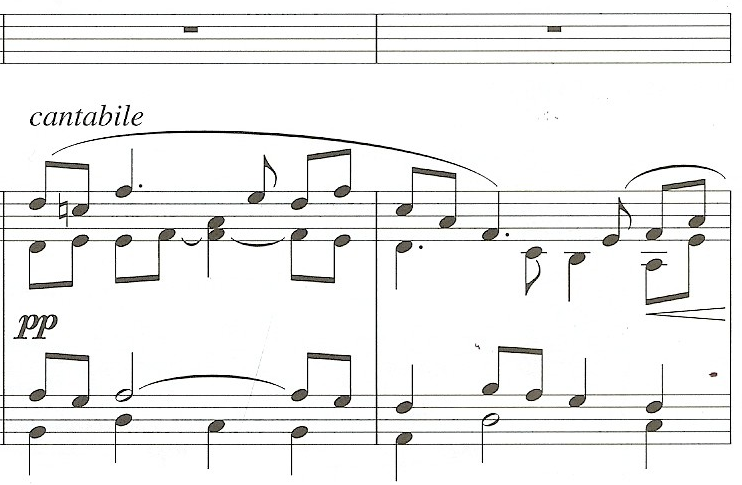
Finzi, returns briefly to the dissonance experienced in the beginning of the song, in measure twenty-one with the text "Foul days and fair" and continuing on to measure twenty-six with the text, "And gust and gale As everywhere." He is normally more subtle with his use of text painting but this example is definitely a blatant one especially the clashing diminished and minor chords under the text "Foul" (see example below).
Use of dissonance in measures 21-6. (Finzi, 90-1)
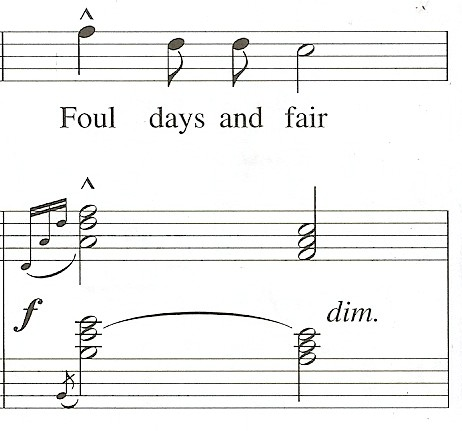

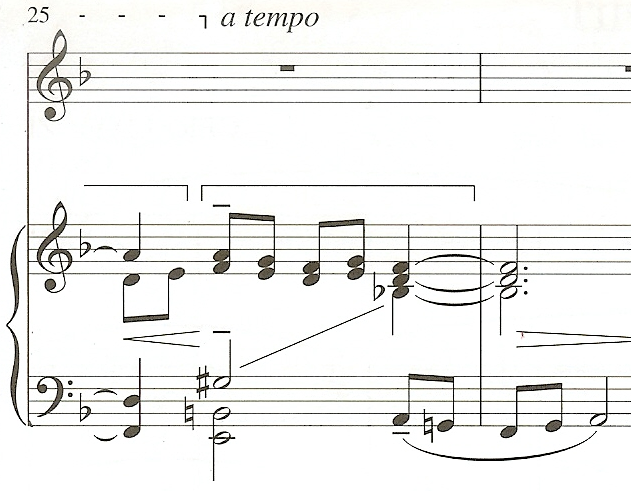
One of the most ethereal moments in the song occurs in measures thirty-two through thirty-five. Here, Finzi has placed the vocal line quite high and asked for a pianissimo dynamic. The vocal line is supported nicely with block chords and then as the text is drawing to the end the piano accompaniment takes over and reminds one of the love that is lost. The loss is very apparent with the dissonance on display within the inner voices. Finzi writes beginning in measure thirty-six an augmented sixth on the first beat of the measure and then on the last beat of the same measure he writes a G-sharp in the right hand while holding a D and an A in the left. He returns to the same dissonance on the second beat of measure thirty-seven but this time the left hand lowers from A to G-sharp before resolving to a D minor chord for the cadence (see example below).
Ethereal moment contrasted with dissonance found in the piano accompaniment in measures 32-8. (Finzi, 91)
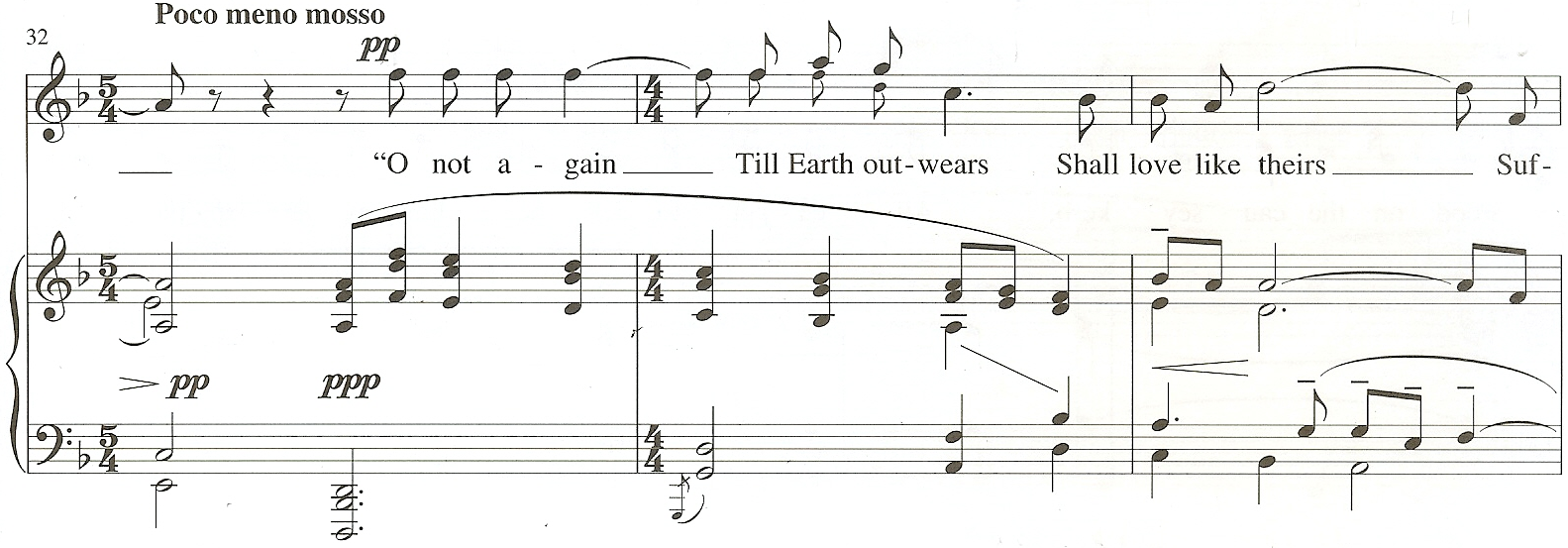
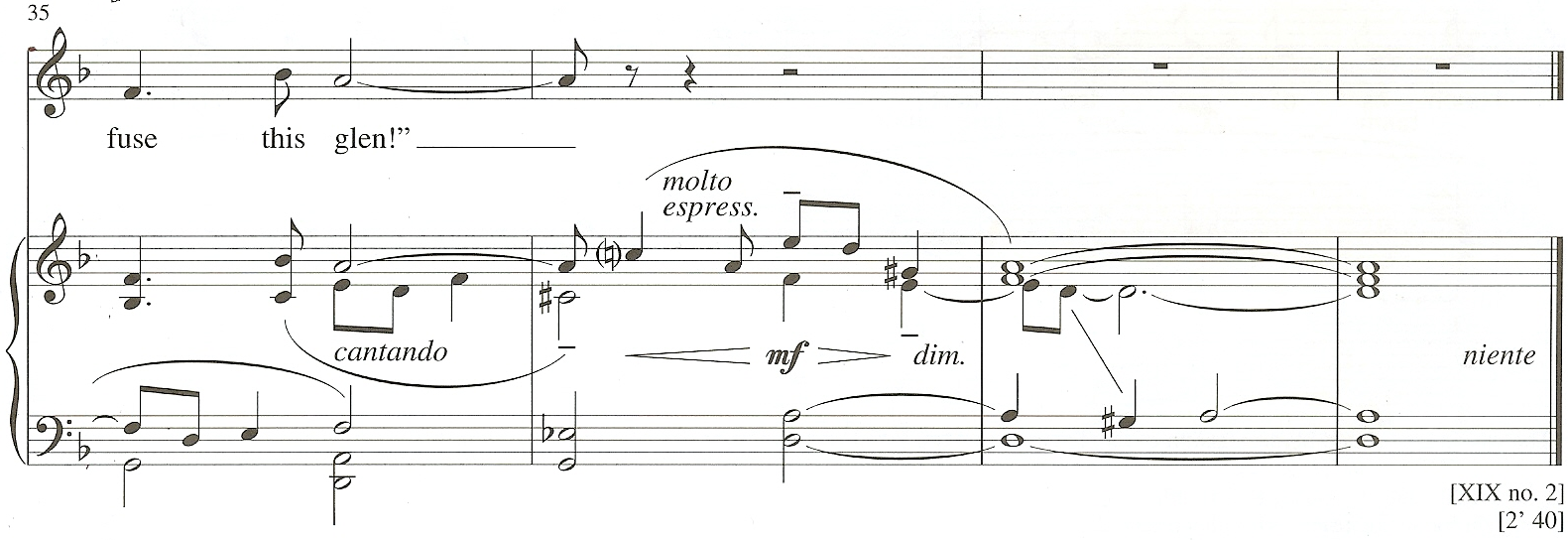
Transposition: The song is available a minor third lower than the original key. The transposed version may be found in the Medium/Low Voice edition by Boosey & Hawkes entitled: Gerald Finzi Collected Songs 54 Songs Including 8 Cycles or Sets.
Duration: Approximately three minutes and twenty-three seconds.
Meter: The song primarily utilizes 4/4 meter but there are three occurrences of 5/4. The first occurrence of 5/4 coincides with the word "love" and Gerhardus Daniël Van der Watt believes it was Finzi's intention to elongate the word is why he chose to use 5/4 in this instance. The next occurrence of 5/4 meter, in measure eleven, coincides with a pensive interlude as the first stanza of text concludes. The last occurrence in measure thirty-two serves as a fermata of sorts giving extra time for the voice to prepare to sing very softly in his upper passaggio. For a listing of meter shifts as well as some suggestions as to why Finzi chose them please refer to: Metre - Van der Watt.
Tempo: The tempo is indicated as Andante with the quarter note equalling c. 66. There are a number of deviations from Andante and Mark Carlisle believes they "add considerable variety to the sense of musical direction and phrasing." (Carlisle, 39) Dr. Carlisle has also included in his analysis of this song a section entitled: "Comments about Performance," within these comments Dr. Carlisle makes several suggestions about the observance of the various tempi markings. To view his comments please refer to: Comments about Performance - Carlisle. Gerhardus Daniël Van der Watt has prepared a table listing the changes in tempo and he has also included some suggestions as to why Finzi may have utilized them. To view Dr. Van der Watt's table and remarks please refer to: Speed - Van der Watt.
Form: The song can be best described is through composed. Mark Carlisle suggests in his comments that the "musical unification in this piece rests almost entirely on Finzi's ability to organize and shape each of the sections in such a way that the listener always has a clear sense of resolution of one stanza or section before moving on to another." (Carlisle, 41) To view Dr. Carlisle's remarks please refer to: Form - Carlisle. Gerhardus Daniël Van der Watt has prepared a table in his dissertation outlining the various sections of the song he also comments "rhythmic and harmonic material is largely responsible for retaining the unity which can easily be lacking in a through-composed song. To view Dr. Van der Watt's table and remarks please refer to: Structure - Van der Watt.
Rhythm: The most common rhythmic duration found within the song is the eighth note which seems to be the "workhorse" for most of Finzi's songs. Finzi's use of rhythm in the song once again shows his skill at text setting. One can find examples of his uncanny ability to capture the rhythm for a particular word by observing his setting of "Lit by a living love" and "knew nothing of" (see example below).
Text setting in measures 6 and 7-8. (Finzi, 89)


His setting of repetitive text in measure twenty is another display of his ability to deal with the difficulty of repeating the same word while accomplishing emphasis without exaggeration (see example below).
Text setting in measure 20. (Finzi, 90)
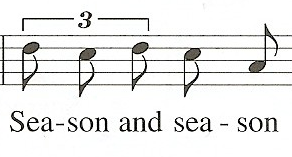
For additional information about the use of rhythm and rhythmic motifs within the song please refer to Dr. Van der Watt's analysis: Rhythm - Van der Watt.
A rhythmic duration analysis was performed for the purpose of determining the number of occurrences a specific rhythmic duration was used; the phrase in which it occurred; the total number of occurrences in the entire song. To view the results of the analysis please refer to: Rhythm Analysis.
Melody: The melodic material found in the vocal line is almost always influenced by the text in a Finzi song but in this song he seems to favor a more philosophical approach to his vocal writing. Consider the first stanza, there are eight lines of poetry and out of the eight, six ascend melodically after the first note. Typically, ascending melodic patterns are thought to be positive. With this in mind, consider the text that corresponds to these six lines: "Lit by a living love (P) / The wilted world knew nothing of:(N) / Scared momently (N) / By gaingivings, (N) / then hoping things (P) / That could not be" (N). Two-thirds of the lines are negative but have ascending melodic material. Perhaps instead of wallowing in self-pity Finzi writes the lines more positive, thus, attempting to make the listener have more sympathy because of the mixed emotions.
The melodic material found in the beginning of the second stanza and even before in the interlude that connects, paints with a pastoral brush a sensitive almost melancholy melody. The section seems to be punctuated with ascending leaps and the largest, a minor tenth, is the trigger for new melodic material to enter as Finzi prepares a storm albeit a brief one before returning to a more tranquil melodic vocal line to finish out the song.
The mood of the melodic material within the song is generally contemplative and pensive with interjected moments of excitement. Mark Carlisle characterizes the second and third stanzas as "more narrative in style than stanza one" (Carlisle, 40) and the melodic material bears this out. Gerhardus Daniël Van der Watt in his analysis says, "The mood of the song has two aspects: the tragi-dramatic exposition of the circumstances in stanza 1 which returns sporadically (b. 24-28 and 34-39) and the more neutral pastoral mood which characterizes the bulk of stanzas 2 and 3. This pastoral mood is not particularly positive but rather tries to express the recurrent nature of the seasons, indifferent to whether the lovers are alive or dead. The most positive moments in the song are from bars 29 - 33 in which a relatively thin texture and convincing F major tonality enhance the atmosphere." (Van der Watt, 375) To view Dr. Van der Watt's remarks in total about the melodic material within the song please refer to: Melody - Van der Watt.
An interval analysis was performed for the purpose of discovering the number of occurrences specific intervals were used and also to see the similarities if there were any between stanzas. Only intervals larger than a major second were accounted for in the interval analysis. For a complete description of the results of the interval analysis please see the table at the bottom of the page or click on: Interval Analysis.
Texture: For a brief description about the texture including a table outlining the types of texture and the percentage in which they were used please refer to: Texture - Van der Watt.
Vocal Range: The vocal range spans an interval of a major thirteenth. The lowest pitch is the C below middle C and the highest pitch is the A above middle C.
Tessitura: The tessitura spans a minor tenth from the D below middle C to the F above middle C. A pitch analysis was performed for the purpose of accurately determining the tessitura and for the complete results please refer to: Pitch Analysis. Mark Carlisle in his "Comments about Performance" section has included some remarks about the tessitura as well as the difficulty of this song to interpret correctly. Dr. Carlisle feels this song should be left to "performers with a fairly high level of musical sophistication." (Carlisle, 43) To view Dr. Carlisle's remarks please refer to: Tessitura - Carlisle.
Dynamic Range: There is quite a range of dynamics in the song, spanning the distance of pianissimo to fortissimo. For this song to be most effective it requires special attention and observance of the numerous dynamic marks throughout the score. In reference to observing the dynamics, Mark Carlisle comments in his analysis with regards to the last section of the song: "the pianissimo in measures 32-33 in the vocal line should most certainly be observed, as the text at that moment represents the 'faery sound' mentioned in the previous poetic line. A dynamic level much greater than this would only reduce the text at that moment to mere commentary, rather than allow it the 'magical' quality that it needs." (Carlisle, 43) Gerhardus Daniël Van der Watt has also included comments about the dynamics in his analysis. He compartmentalizes into five different areas including a table listing all the dynamic marks, a section for the frequency of the marks, another section for the range of the marks, still another section for the variety of the marks, and lastly, a section entitled: "Dynamic Accents" which may be of interest for those looking for help with interpretation. To view Dr. Van der Watt's comments please refer to: Dynamics - Van der Watt.
Accompaniment: As was mentioned in the Form category above the unification of the different sections of the song are accomplished by several things including the shaping of each section, the rhythm, the harmony, but more importantly the dynamics and tempo markings putting most of the work on the accompanist. Mark Carlisle has made some comments about performance practice in his analysis and to view them please refer to: Dynamics - Carlisle. Gerhardus Daniël Van der Watt has made some comments in his analysis pertaining to the "Accompaniment Characteristics." These may be of assistance to the pianist as well as those analyzing Finzi's composition for the piano accompaniment. To view Dr. Van der Watt's remarks please refer to: Accompaniment - Van der Watt.
Published comments about the music: Diana McVeagh in her Finzi biography comments about In years defaced: "Hardy once again treats of time and human love. Verse 1 describes the secret lovers of long ago; Finzi's doleful introduction picks up the past sadness, his upward rush of semi-quavers the couple's sudden emotion, a stabbing appoggiatura the world's indifference, the bass disturbance the lovers' fears. By verse 2 that is in the past, and an exquisite couple of cantabile piano bars lead to the relative major and Finzi's most serene manner, though the 'gale' figure reflects the couple's 'fears'. In verse 3 Hardy revives the old folk-belief that shepherds have the power to catch echoes of long-ago emotions, which Finzi's limpid piano descant to the 'lonely shepherds' affirms. In a magical phrase, placed high so as to sound ethereal, the singer whispers that such love will for ever linger in that place. The intervals of 'till earth outwears' at the end are the same as 'two sat here' at the beginning, an identification both musical and poetic. The whole song is permeated by that three-note-figure - two conjunct notes down and a leap up of a fifth - transformed, inverted, placed at differing points in a phrase." (McVeagh, 81-2)
Pedagogical Considerations for Voice Students and Instructors: This song is well suited for the tenor voice in the high key and is equally good for the baritone in the medium/low key. There are some range issues to negotiate and they may be extremely difficult for a young voice. If the dramatic high note in measure twenty-three on the text, "everywhere" is difficult, observe the vowel on the penultimate note and text. Try the word "as" in a slightly forward position. This may help the high note on "every" to not be too heavily produced. Careful consideration and observation should also be made to not allow either note to spread. Another particularly difficult passage occurs in measures thirty-two and thirty-three where both the dynamics and the range create a beautiful phrase but one that will require some thought-filled practice to negotiate successfully. The first suggestion is to observe one's breath, making sure the breath is not held or pinched. The long note on "again" needs to have a thought of forward momentum which then will carry the voice through the end of the phrase. The consonants are best created in this phrase very lightly being careful to manage the articulation lightly with the tongue.
Dr. Mark Carlisle records in his dissertation the following observations and advice: "Several dynamic markings are indicated, mostly in the accompaniment, and they follow particularly well the poetic energy at any given moment; the more intense the poetic reference, the more dynamic variety will be necessary. It is, of course, up to each performer to decide the extent of dynamic variety required in this piece, but it seems fair to say that the opening section will need more dynamic variation in order to be effective than will the following two sections. It is the most personal of the three poetic stanzas, with underlying music that relies more on harmonic factors than melodic range or tessitura for its musical motion. Therefore it is up to the singer to supply the necessary dynamic contrast if this section is to be effectively sung." (Carlisle, 42)
"The latter two sections contain melodic music more diverse in range and tessitura requirements than the opening section, as well as poetry more narrative in character, so the overt necessity to supply dynamic variety is not as great for the singer. However, the pianissimo in measures 32-33 in the vocal line should most certainly be observed, as the text at that moment represents the "faery sound" mentioned in the previous poetic line. A dynamic level much greater than this would only reduce the text at that moment to mere commentary, rather than allow it the "magical" quality that it needs." (Carlisle, 42-3)
"This piece does have a few difficult tessitura or range problems to overcome, such as those found in measure 23 and measures 32-33, which require considerable technical competence on the part of the singer in order to make the passages musically effective. However, many subtle tempo and dynamic changes, as well as a poem of some literary difficulty, create even greater problems that can only be adequately solved by performers with a fairly high level of musical sophistication. While an upper-level undergraduate tenor might be capable of performing this piece well, it is more highly recommended to graduate students who have usually attained a greater degree of literary, interpretive, and technical competence than found at the undergraduate level." (Carlisle, 43)
✦✼✦✼✦✼✦✼✦✼✦✼✦✼✦✼✦✼✦✼✦✼✦✼✦✼✦✼✦✼✦✼✦✼✦
Below one will find excerpts from unpublished dissertations. The excerpts should provide a more complete analysis of In Years Defaced for those wishing to see additional detail. Please click on the link or scroll down.
Gerhardus Daniël Van der Watt - The Songs of Gerald Finzi (1901-1956) To Poems by Thomas Hardy
✦✼✦✼✦✼✦✼✦✼✦✼✦✼✦✼✦✼✦✼✦✼✦✼✦✼✦✼✦✼✦✼✦✼✦
| Pitch Analysis | |||||
|---|---|---|---|---|---|
| pitch | stanza 1 |
stanza 2 |
stanza 3 |
total | |
highest |
A |
1 |
1 |
2 |
|
G |
1 |
1 |
|||
F |
2 |
6 |
8 |
||
E |
1 |
2 |
3 |
||
D |
3 |
8 |
3 |
14 |
|
middle C |
4 |
7 |
4 |
15 |
|
B |
4 |
1 |
6 |
11 |
|
A |
7 |
9 |
9 |
25 |
|
G |
7 |
3 |
3 |
13 |
|
F |
5 |
4 |
6 |
15 |
|
E |
5 |
1 |
6 |
||
D |
6 |
2 |
1 |
9 |
|
lowest |
C |
3 |
1 |
4 |
|
✦✼✦✼✦✼✦✼✦✼✦✼✦✼✦✼✦✼✦✼✦✼✦✼✦✼✦✼✦✼✦✼✦✼✦
Audio Recordings
The English Song Series - 16 |
|
|
|
Song Cycles for Tenor & Piano by Gerald Finzi |
|
|
|
Finzi |
|
|
|
Oh Fair to See: Songs by English composers |
|
|
|
Songs of the Heart: Song Cycles of Gerald Finzi |
|
|
|
The following is an analysis of In years defaced by Gerhardus Daniël Van der Watt. Dr. Van der Watt extended permission to post this excerpt from his dissertation on October 8th, 2010. His dissertation dated November 1996, is entitled:
The Songs of Gerald Finzi (1901-1956) To Poems by Thomas Hardy
This excerpt comes from Volume II and begins on page three hundred sixty-seven and concludes on page three hundred sixty-eight. To view the methodology used within Dr. Van der Watt's dissertation please refer to: Methodology - Van der Watt.
1. Poet
Specific background concerning poem:
"The poem comes form Poems of the Past and the Present (1901), Hardy's second anthology, and is undated, In the preface to the 1901 edition, Hardy writes:"
(Van der Watt, 367)
"Of the subject matter of this volume - even that which is in other than narrative form - much is dramatic or impersonative even where not explicitly so . . . Unadjusted impressions have their value and the road to a true philosophy of life seems to lie in humbly recording diverse readings of its phenomena as they are forced upon us by chance and change." (Hardy, 84) (Van der Watt, 367) |
"The poem is exactly such a 'dramatic impression' resulting from 'chance and change'."
(Van der Watt, 367)
2. Poem
"The persona recalls two lovers in a specific place. Exactly who they are and what happens to them is not clear. Though together and in love, the world seems indifferent about them: their lives, love and suffering goes seemingly, unnoticed. There is no trace of them now, Nature has taken its toll and Time has all but erased the memory of them. Yet, sensitive and innocent souls, like shepherds, may well hear an enchanted murmur extolling the merits of their excellent love: never until the end of time, will there be such a love in this place again."
(Van der Watt, 367-8)
"The poem is not really about the lovers but rather about the quality of their love and the world's indifference to them. The theme of the worlds's indifference to man, recurs periodically in Hardy's writings."
(Van der Watt, 368)
"The poem is in the style of a pastoral lyric. There are numerous references in the poem to nature as well as to shepherds and fairies, which establish and strengthen the pastoral tone."
(Van der Watt, 368)
"The poem has three stanzas, each in turn consisting of eight lines of uneven length. The fourth line of each stanza is significantly longer and is isolated by being placed left of the normal stanza position. Lines 5-8 of each stanza are shorter than the rest. There seems to be no direct relation between this particular formal structure and the content of the poem. Hardy did experiment with form for the sake of form, the longer line being emphasized visually. The rhyme scheme is a mixture of paired and rounded rhyme: aabbcddc eeffghhg iijjkllk. The metre is largely iambic although there are a number of trochaic inversions (1, 2, 3, 12, 13, 14 and 21)."
(Van der Watt, 368)
"The poem's actual narrative is quite obscure. No information is given about the individuals or the circumstances which give rise to them being in the particular spot. The vagueness seems to be deliberate to focus the reader's attention on the main aim of the poem: to bring a tribute to the lover's unfailing love. The situation does, however, remind one of the closing section of Tess of the D'Urbervilles, when Tess and Angel Clare are together for the last time before she is arrested."
(Van der Watt, 368)
Setting
1. Timbre
VOICE TYPE/RANGE
"The song is set for tenor voice and the range is a major thirteenth from the first C below middle C."
(Van der Watt, 368)
"The highest pitch used in the piano accompaniment, is the second F above middle C (b. 15, 20, 22, 23) and the lowest the third A below middle C (b. 13, 19). A middle to lower sonority is employed in the song which serves the tormented atmosphere well."
(Van der Watt, 368)
"There are no indications of the use of pedalling. The legato indictions and pianistic material signal that pedalling is left to the discretion of the performer. Legato touch is the prevailing articulation indication. In some bars (eg. b. 21 and 23) it is not clear which touch attack the composer requires. Does he here require non-legato chord playing or does one assume that these chords should be pedalled? The latter seems more appropriate but conclusive information is not provided. Portamento accents are used in a number of bars to highlight specific notes or melodic motifs (b. 5, 8, 13(2), 17, 26(2), 35(5), 37(3)). Three stronger accents occur in the song: in bar 8 (>) on the word "wilted" (chord: Ger Aug). bar 13 (^ fz) associated with the text, "That could not be" (chord: V maj\min) and bar 22 (^) on the word, "Foul" (chord: vii¹¹). These accents occur on dissonant moments, enhancing the effect of loss."
(Van der Watt, 368-9)
"The setting is fairly chromatic (secondary dominants, Neapolitan chord, a German Augmented chord, a Dominant major-minor chord and chords with added tones) and extended triads are used freely (vii¹¹, ii⁹, I⁷, ii⁷, iv⁷, VI⁷). There is, furthermore, an extensive use of appoggiaturas, passing notes and upper and lower auxiliary notes. These non-essentials on the beat enhance the dissonance, already apparent in the harmonic language. These features, collectively, result in a rather dramatic atmosphere. The sense of drama is further enhanced by the tempo changes (b. 7, 9, 12, 17, 24, 27 and 32-3). Stanza 2, introduced by a short interlude marked cantabile (b. 15-23) has a more peaceful pastoral atmosphere and the same is true of section in stanza 3 (b. 29-33). The sense of loss returns from bar 33³ (Poco meno mosso) and intensifies towards the end of the song (b. 36 cantando, b. 37 molto espress. b. 39 niente)."
(Van der Watt, 369)
2. Duration
"The text metre is mainly iambic and is matched with common-time time-signature in 35 of the 39 bars. All deviations from the main metre are listed below:"
Bar no. |
Metre |
No. of bars |
Total |
Suggested reason/s |
7 |
5/4 |
1 |
4 |
Emphasis of "love" by extending the note value, F maj modulation |
8 |
4/4 |
4 |
35 |
"wilted" on a strong beat |
12 |
5/4 |
2 |
Prolonging "be", emphasis on maj-min chord |
|
14 |
4/4 |
19 |
Cadence back in prevailing metre |
|
33 |
5/4 |
1 |
Prolonging cadential chord before slower tempo |
|
34 |
4/4 |
6 |
Return to prevailing metre |
"Another more subtle metric change occurs in bars 24 and 25. The composer indicates this by means of a square bracket above the piano and vocal parts: in the three bars, four segments of 3/4 are indicated. This internal metric change coincides with the text, "And gust and gales As everywhere" and strengthens the idea of a gusty wind. The semi-quaver ostinato figure in the alto part of the piano intensifies the idea of a whirlwind."
(Van der Watt, 369)
Rhythmic motifs
"The rhythmic motif basically consisting of four quavers (motif 1) occurs 17 times in both piano and vocal parts (b. 2, 6, 8, 15, 19, 20, 24, 26, 29(2), 30(4) and 32(3) but has a more significant variation. The variation consists of a quaver rest or quaver tied to the previous bet and three quavers and occurs 13 times in both piano and vocal parts (b. 1(2), 4(2), 11, 13, 15, 16, 17(2), 31, 33). Motif 2, consisting of two quavers and a crotchet, occurs 35 times, mainly in the piano part. Motif 3, consisting of two crotchets, providing the basic metric unit and harmonic rhythm, occurs 39 times. A less prevalent but quite significant motif (motif 4), consisting of four semi-quavers occurs in bars 7³, 9⁴- 10⁴and 24²-25⁴. These sudden burst of rhythmic activity are in each cas related to the text: in bar 7, the ascending scaler passage reinforces the "living love"; in bars 9-10 the motif represents fear, "Scared momently by gaingivings"; and in bars 24-25 the motif suggests the "gust and gale . . . everywhere" of the adjacent text. This semi-quaver figure in bars 25 is rhythmically augmented in bar 26 - 28 and in so doing the "gust and gale" slowly subsides."
(Van der Watt, 369-70)
Rhythmic activity vs. Rhythmic stagnation
"There is a fairly inconsistent ebb and flow of rhythmic material which is partly responsible for the sense of suffering and drama. The standard unit of movement is the quaver though it is often departed from. The more active bars have been mentioned in the previous section. More stagnant rhythmic material occurs in bars 20 - 23, the accompanying text being: "The sun and shadow wheel, \ Season and season sereward steal: \ Foul days and fair \ Here, too, prevail". Bars 33 - 34 are also rhythmically less active, here for the sake of clarity of the climactic text, "O not again \ Till earth outwears"."
(Van der Watt, 370)
Rhythmically perceptive, erroneous and interesting settings
"The following words have been set to music perceptively:"
 (Van der Watt, 370)
(Van der Watt, 370)
Lengthening of voiced consonants
"The following words containing voiced consonants have been rhythmically prolonged in order to make the word more singable:"

(Van der Watt, 370)
"The tempo indication is Andante [quarter note equals] c. 66. Tempo deviations are numerous and listed below:"
Bar no. |
Deviation |
Bar no. |
Return |
Suggested reason/s |
7 |
poco accel. |
8 |
a tempo |
Support text: reference to "love" |
9 |
poco accel. |
11 |
rit. a tempo |
Support text: agitation |
12 |
allargando |
13 |
a tempo |
End of stanza 1 |
17 |
rit. |
18 |
a tempo |
Opening of stanza 2 |
24 |
accel. |
25-6 |
rit. . .a tempo |
Support text: "gust and gale" |
27 |
rit. |
28-9 |
a tempo |
Opening of stanza 3 |
32 |
rit. |
33 |
Poco meno mosso |
Emphasis - final statement |
3. Pitch
Intervals: Distance distribution
Interval |
Upwards |
Downwards |
Unison |
(18) |
|
Second |
20 |
33 |
Third |
8 |
8 |
Fourth |
9 |
3 |
Fifth |
5 |
9 |
Sixth |
4 |
1 |
Octave |
1 |
1 |
Tenth |
1 |
0 |
"There are 18 repeated pitches (or 15% of the total number), 48 rising intervals (or 40% and 55 falling intervals (or 45%). The smaller intervals (a third and smaller) account for 121 intervals (72% of the total number) while the larger intervals (fourths and larger) account for 34 (or 28%). The interval use is fairly sympathetic towards the voice. A large number of specific setting are discussed below."
Interval |
Bar no. |
Word/s |
Reason/s |
5th up |
4-5 |
defaced |
Emphasis |
5th down |
6 |
transport |
Reinforce emotional content |
5th up |
7-8 |
The wilted |
Emphasis |
5th down |
8 |
nothing |
Reinforce emotional content |
5th up |
9-10 |
by gaingivings |
Emphasis |
6th up 5th down |
11 |
hoping things that |
Reinforce emotional content |
8th up |
17-8 |
of love |
Emphasis |
5th down |
18 |
no trace |
Reinforce meaning |
6th up |
19 |
upon |
Emphasis |
6th up |
19-20 |
The sun |
Emphasis, reinforce meaning |
10th up |
21-2 |
steal: Foul |
Emphasis |
5th down |
23 |
prevail |
Reinforce emotional content |
5th up 8th down |
24 |
As everywhere |
Emphasis |
5th down |
30 |
these knolls |
Reinforce emotional content |
6th up |
30-1 |
a faery |
Emphasis |
5th down |
32 |
noontides from |
Reinforce emotional content |
5th down |
34 |
outwears |
Reinforce emotional content |
5th down |
35 |
theirs suffuse |
Reinforce meaning |
"Nine descending and five ascending perfect fifths are used in the song. The descending use is of particular significance: the interval is associated with emotionally sympathetic moments in the text as is clear from the table. The large leap of a minor tenth (b. 21-2) is very effective in its emphasis of the word "Foul"."
(Van der Watt, 371)
Melodic curve
"A melodic curve of the vocal line is represented below. Certain words are indicated to show the relationship between the melodic curve and the meaning:"
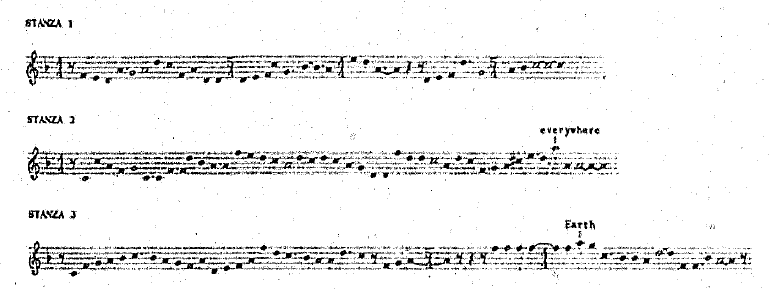 (Van der Watt, 372)
(Van der Watt, 372)
Climaxes
"The two vocal climaxes are given below:"
Bar no. |
Pitch |
Word |
24 |
A |
Earth |
34 |
A |
everywhere |
Phrase lengths
"In relatively few cases rests are provided to accommodate breathing between phrases. Breathing will have to be planned carefully within this fairly slow context. Here are some suggestions as to where breathing might take place:"
Stanza 1: |
5⁴and 7⁵ |
Stanza 2: |
20⁴, 21⁴and 23⁴ |
Stanza 3: |
31³ and 34⁴ |
"Although the song starts and ends in D minor there are many modulations to F major. All modulations are summarized below."
Modulation
Bar no. |
From - To |
Suggested reason/s |
7 |
d - F |
Support text: "Lit by a living love" |
8 |
F - d |
Support text: "Wilted world" |
11 - 12 |
d - F |
The idea of "hope" is set in the interlude |
13 |
F - d |
Loss of "hope" sets in abruptly in the interlude |
15 |
d - F |
Interlude to second stanza, more pastoral mood |
24 |
F - d |
The idea of "gust and gale" set in a minor key |
29 |
d - F |
Reference to pastoral features |
34 |
F - d |
Final statement - returns to tragic mood |
Chromaticism
"Chromaticism is a very strong feature in the song and is largely responsible for the sense of wistfulness which overshadow the mood of the song. All instances of chromaticism are listed below:"
Bar |
Key |
Chord\Note |
Function\Reason |
3⁴ |
d |
V¹¹\V + accented passing notes (E & C) |
Prelude - setting of wistful mood |
4¹ |
d |
V⁹ (B natural) |
Prelude - setting of wistful mood |
5¹ |
d |
Nap⁶ |
Text supported: "defaced and lost" |
5² |
d |
iii⁶ + lowered 5th (B natural) |
Text supported: "defaced and lost" |
8¹ |
d |
Ger Augmented⁶ |
Text supported: "wilted world" |
8³ |
d |
Nap⁶ |
Text supported: "wilted world" |
10¹ |
d |
vii°₇ + lowered root (C natural) |
Text supported: "gaingivings" (misgivings) |
13¹ |
d |
V major\minor (C# + C natural) |
Interlude - text reconsidered: "That could not be" |
14¹ |
d |
Nap⁶ |
Interlude - enhance sense of drama |
17¹ |
F |
Nap⁶ |
Interlude - enhance sense of drama |
26² |
d |
V¹¹\V |
Interlude - enhance tragic atmosphere |
37¹ |
d |
Nap⁶ + appoggiatura (C natural) |
Postlude - enhance drama |
37⁴ |
d |
G # appoggiatura |
Postlude - express sadness |
38² |
d |
G # appoggiatura |
Postlude - express sadness |
HARMONY AND COUNTERPOINT
"A number of non-chromatic chord extensions are used to create dissonance which further enhances the sense of drama further (b. 4¹ - V⁹, 6³ - iv⁹, 20³ - vi⁹, 22¹ - vii¹¹ and 23¹ - ii⁹)."
(Van der Watt, 373)
Non-harmonic tones
"Three kinds of accented non-essential tones are used extensively:"
Appoggiatura: |
Bars 3⁴(C and E), 8¹(E), 17¹(C), 32⁴(E), 37³(E), 37⁴(G#) |
|
Accented Passing Note: |
Bars 4⁴(E & G), 10²(B flat), 11²(E), 13¹(C), 20³(E, C and G), 26⁴(A), 34¹(C, A and C). |
|
Accented Auxiliary note: |
Bars 8²(E), 14²(F), 18³(A & C), 32¹(A), 38²(G#) |
"Suspensions are too numerous to be mentioned individually but they, along with the above mentioned, all have the same function, namely creating dissonance on the bet for the sake of expression. The wistful and sometimes dramatic mood created in the song is largely enhanced by the use of these non-essential tones, they in fact become an essential, integral part of the expressive language of the song."
(Van der Watt, 373)
Harmonic devices
"One extended pedal note occurs: in bars 1 - 4 and F is sounded in the treble clef. The function here is to create some tonal stability on the one hand and to enhance dissonance when chords clash with the F. The main atmosphere of the song is set in this way, from the very first moment."
(Van der Watt, 373)
Counterpoint
"A number of varied imitations between the vocal and piano parts occur:"
Bar 7¹-⁴voice - 7²-⁵ piano |
|
Bar 8³-⁴ voice - 9²-³ piano |
|
Bar 20¹-³voice - 20²-⁴piano |
|
Bars 34⁴ - 35² voice - 35²-⁴, 36²-³, 36³-⁴piano |
|
Bar 36¹-³ voice - 37²-⁴piano |
"the practice of cross-reference between the vocal and piano parts creates unity in the song. In this case, where each reference is varied or distorted, the sense of loss is further enhanced. Internally, in the piano part, there is only one convincing imitation: bar 26²-⁴is imitated in bars 26⁴- 27³ and echoed a semitone higher in bars 27⁴- 28³."
(Van der Watt, 374)
"Loudness variation is given in the following summary:"
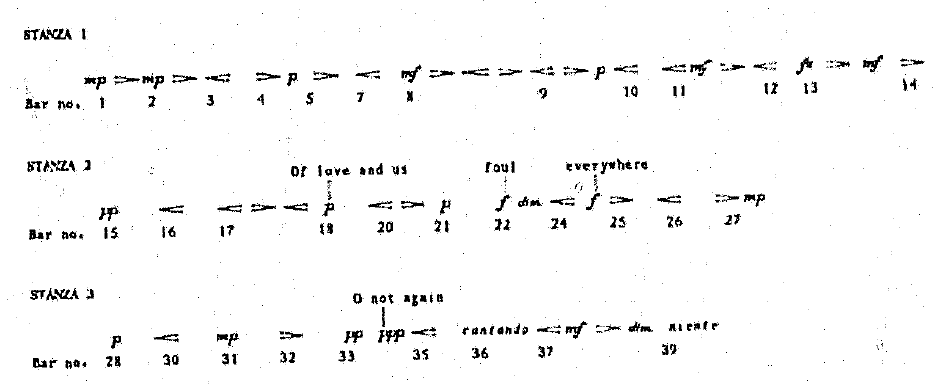 (Van der Watt, 374)
(Van der Watt, 374)
FREQUENCY
"There are 58 indications in the 36 bars which means that on average each bar contains more than one indication. In reality some bars do not contain indications while others contain two or three. There are no separate indications for the voice except in one instance namely, pp in bar 33. This implies that the voice should follow the indications given in the piano part where no other indications are provided."
(Van der Watt, 374)
RANGE
"The lowest level indication used is ppp (b. 33) on the concluding statement in the song, "O not again". The highest level indiction (f) is used on the words "Foul days and fair" (b. 22)."
(Van der Watt, 374)
VARIETY
"The indications used are:"
 (Van der Watt, 374)
(Van der Watt, 374) DYNAMIC ACCENTS
"The portamento accents have been listed and discussed under 'articulation' earlier. There are only three stronger accents:"
- Bar 8 (>) On the German Augmented chord, with the word "wilted"; the tragedy of an indifferent, uncaring world is emphasized.
- Bar 13 (^ fz) On the Dominant Major-Minor chord as part of the interlude which refers back to the text "That could not be"; the shock of the realization is emphasized.
- Bar 22 (^) On chord vii¹¹, with the word "Foul"; the dissonance supports the specific word and also the general context - love long gone without trace.
(Van der Watt, 374-5)
"The density varies loosely between four and seven parts including both piano and voice. The thickness of piano part is represented in the following table:"
No. of parts |
No. of bars |
Percentage |
3 parts |
3 |
8 |
4 parts |
20 |
51 |
5 parts |
10 |
26 |
6 parts |
6 |
15 |
"The four- and five-part textures accounts for the texture in 77% of the bars, making the piano part a fairly thick one. A six-part texture prevails for a short section (b. 20-23) but does not seem to be significantly related to the meaning. Bars 29 - 30 have a three-part texture which can be linked to the pastoral idea of innocent simplicity suggested by the adjacent text, "But lonely shepherd souls"."
(Van der Watt, 375)
"The structure of the song is represented in the following table:"
 (Van der Watt, 375)
(Van der Watt, 375)"The song is of a through-composed structure. Rhythmic and harmonic material is largely responsible for retaining the unity which can easily be lacking in a through-composed song."
(Van der Watt, 375)
7. Mood and atmosphere
"The mood of the song has two aspects: the tragi-dramatic exposition of the circumstances in stanza 1 which returns sporadically (b. 24-28 and 34-39) and the more neutral pastoral mood which characterizes the bulk of stanzas 2 and 3. This pastoral mood is not particularly positive but rather tries to express the recurrent nature of the seasons, indifferent to whether the lovers are alive or dead. The most positive moments in the song are from bars 29 - 33 in which a relatively thin texture and convincing F major tonality enhance the atmosphere."
(Van der Watt, 375)
General comment on style
"The use of vocal-melodic intervals is fairly sympathetic to the voice though there is a 30% incidence of larger leaps including one of a minor tenth. The harmonic language is chromatic and the Neapolitan chord in first inversion becomes a significant feature. Numerous accented non-essential tones further heighten the dissonance. The tempo of the song fluctuates by means of several accelerandi and ritardandi. All these elements have collectively an effective impact on the setting of the atmosphere in the song. In a through-composed structure, the atmosphere suggested by the text is followed carefully."
(Van der Watt, 375)
Unpublished Analysis Excerpts
The following is an analysis of In years defaced by Mark Carlisle. Dr. Carlisle extended permission to post this excerpt from his dissertation on September 7th, 2010. His dissertation dated December 1991, is entitled:
Gerald Finzi: A Performance Analysis of A Young Man's Exhortation and Till Earth Outwears, Two Works for High Voice and Piano to Poems by Thomas Hardy
This excerpt begins on page thirty seven and concludes on page forty-three.
"This is one of the few poems the title of which Finzi chose to change from Hardy's original. Hardy entitled this poem, "A Spot.""
(Carlisle, 37)
Comments on the Poem
"This poem is part of a collection published in 1902, entitled Poems of the Past and the Present. Hardy described the poems in this collections as "a series of feelings and fancies written down in widely differing moods and circumstances, and at various dates."
(Hardy, 84)
(Carlisle, 37)
"In Hardy's Sweetest Image, Lois Deacon suggests that the lovers of which this poem speaks are Hardy and Tryphena Sparks. (Deacon, 9-10) The "spot" that provides the setting for this poem is generally thought to be a sheep pasture called Coombe Eweleaze near Puddletown, less than two miles from Hardy's boyhood home. It was a favorite spot for village festivities, and no doubt a place where Thomas and Tryphena spent much time together."
(Carlisle, 38)
"The unusual structure of the poem bears a remarkable likeness to Psalm 148 in Nicholas Brady's A New Version of the Psalms of David. Hardy was something of a biblical scholar, not withstanding his proclaimed agnosticism, and certainly owned this edition of the Psalms. (Hynes, 84) The poem is certainly one of the more engaging Hardy ever wrote. It depicts for the readier a scene "among the knolls" where once existed an unknown, but very real and passionate love between two people. This love, as strong as it was, could not survive the circumstances of the time, and became only a quiet and solitary memory in the passing of seasons and years. However, for those "lonely shepherd souls" who peacefully spend time in the knolls, they may hear those magical words, "O not again, till earth outwears, shall love like theirs suffuse this glen." It is deeply felt expression of lost love that has been enlivened even more through the power of music."
(Carlisle, 38-9)
"Several words in this poem are unfamiliar to modern day readers, particularly American ones. Therefore, a few definitions are offered to help the reader or performer: "gaingivings" - offerings given in return; "faery" - unreal, magical; "sereward" - toward decay; "transport-tossed" - moved with rapture."
(Carlisle, 39)
Comments on the Music
"Finzi set this poem in a through-composed style, befitting the change of thought and character of each of the stanzas. The opening key signature indicates D minor, but the extensive use of C natural rather than the leading-tone C sharp suggests that the Aeolian mode is the actual harmonic basis of this song. The meter is 4/4 during most of the song, with only a couple of changes to 5/4 during the opening measures, but many expressive tempo markings throughout the song add considerable variety to the sense of musical direction and phrasing."
(Carlisle, 39)
"The first four measures of the song set the style and character of the music for the first stanza, as much dissonance creates the unsettling feeling of looking back on a love that, while true and powerful, was doomed to fail by uncontrollable circumstances. This dissonance, most of which occurs prior to the entrance of the vocal line, is evidenced by the following: descending chromatic lines in the inner voices of the accompaniment; a chord containing major and minor seconds to begin the first full measure; the use of 'blue notes,' in this particular instance C natural and C sharp often found in the same chord or measure; and a secondary dominant chord on beat four of measure 2 that resolves to a very dissonant V chord structure at the beginning of measure 3. This emphasis on dissonance continues through measure 13, when more consonant harmonies begin to appear (see Example 2).
(Carlisle, 40)
"Example 2. 'In Years defaced,' measures 1-7." |
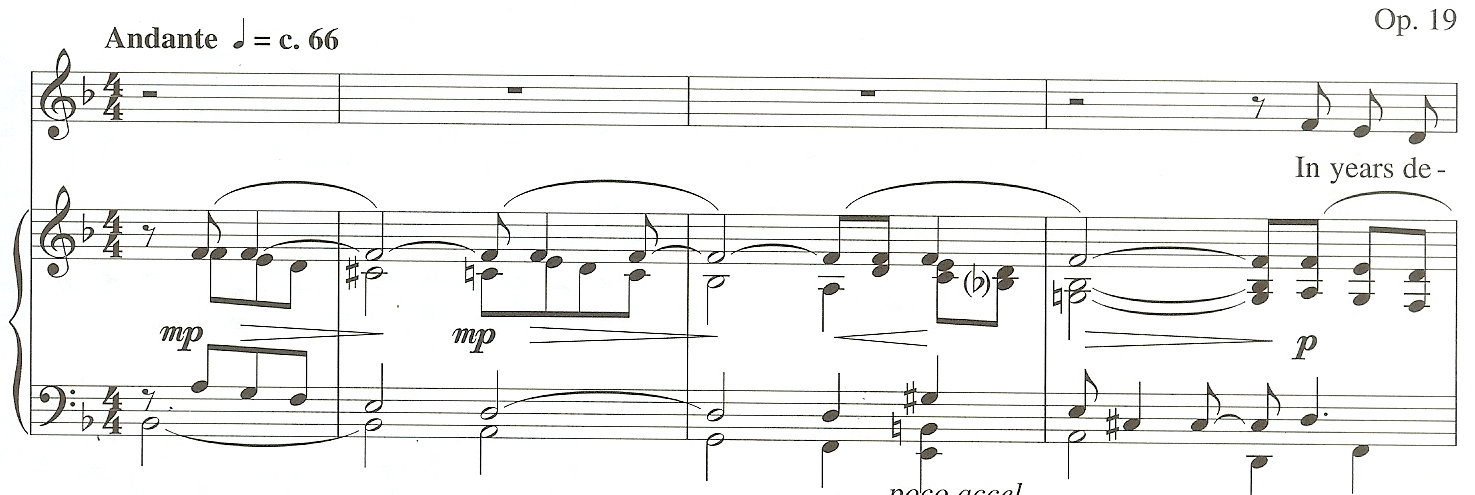

"The second and third stanzas are more narrative in style than stanza one. Finzi has correspondingly written music that now moves from an emphasis on harmonic dissonance to an emphasis on a consonant vocal melody that, while angular, is also quite lyrical and firmly rooted in F major. An intensity of personal involvement that characterizes stanza one is followed by text in which the poet changes to a more reflective perspective of lost love through the passing of seasons. While some dissonance returns in later passages, it does so primarily to characterize a particular textual reference or as a subtle reminder of the pain of an irretrievable relationship. For example, in measures 23-24 the melody outlines an A-major chord, or V in D minor, while underneath the accompaniment moves through a first-inversion sequence of I, ii, and vi, also in D minor. The effect is quite dissonant, a reflection of the text at that moment, 'and gust and gale as everywhere.' Dissonance in the framework of a secondary dominant chord in D minor occurs in measures 25 and 36, with a G sharp in measure 37 providing an 'echo' of the V/V chord. All of these punctuate otherwise minor mode harmonies, thus serving to remind the listener of the underlying sadness and pain of the poetry."
(Carlisle, 40-1)
"There is little in this piece that can be construed as motivic or musically unifying. Rapid sets of sixteenth notes are found in measures 6, 9, and 23-24, but these serve only to reflect the text, highlighting textual moments of excitability or anxiety. Musical unification in this piece rests almost entirely on Finzi's ability to organize and shape each of the sections in such a way that the listener always has a clear sense of resolution of one stanza or section before moving on to another." (Carlisle, 41)
Comments about Performance
"Finzi has provided an opening tempo of [quarter note] = c. 66 (Andante) that is fine to begin, but the many expressive markings throughout the song indicate a great need for much flexibility. Particularly important are the poco accelerando markings in measures 6 and 8, and the accelerando in measure 23, all of which supply important musical energy to the text at those moments. Also important is the poco meno mosso at measure 32, again a necessary musical requirement if the text at the end of this piece is to have the expressiveness it so very much needs." (Carlisle, 42)
"Several dynamic markings are indicated, mostly in the accompaniment, and they follow particularly well the poetic energy at any given moment; the more intense the poetic reference, the more dynamic variety will be necessary. It is, of course, up to each performer to decide the extent of dynamic variety required in this piece, but it seems fair to say that the opening section will need more dynamic variation in order to be effective than will the following two sections. It is the most personal of the three poetic stanzas, with underlying music that relies more on harmonic factors than melodic range or tessitura for its musical motion. Therefore it is up to the singer to supply the necessary dynamic contrast if this section is to be effectively sung."
(Carlisle, 42)
"The latter two sections contain melodic music more diverse in range and tessitura requirements than the opening section, as well as poetry more narrative in character, so the overt necessity to supply dynamic variety is not as great for the singer. However, the pianissimo in measures 32-33 in the vocal line should most certainly be observed, as the text at that moment represents the "faery sound" mentioned in the previous poetic line. A dynamic level much greater than this would only reduce the text at that moment to mere commentary, rather than allow it the "magical" quality that it needs." (Carlisle, 42-3)
"This piece does have a few difficult tessitura or range problems to overcome, such as those found in measure 23 and measures 32-33, which require considerable technical competence on the part of the singer in order to make the passages musically effective. However, many subtle tempo and dynamic changes, as well as a poem of some literary difficulty, create even greater problems that can only be adequately solved by performers with a fairly high level of musical sophistication. While an upper-level undergraduate tenor might be capable of performing this piece well, it is more highly recommended to graduate students who have usually attained a greater degree of literary, interpretive, and technical competence than found at the undergraduate level."
(Carlisle, 43)
Unpublished Analysis Excerpts
The following is an analysis of In years defaced by Leslie Alan Denning. Dr. Denning extended permission to post this excerpt from his dissertation on September 8th, 2010. His dissertation dated May 1995, is entitled:
A Discussion and Analysis of Songs for the Tenor Voice Composed by Gerald Finzi with Texts by Thomas Hardy
This excerpt begins on page seventy-five and concludes on page seventy-eight of the dissertation.
"'In Years Defaced' employs Hardy's poem entitled A Spot written in August 1901 and published in Poems of the Past and Present. Finzi's setting dates form April 1936 and is typical of his work yet presents some new facets of the composer's ability. While Finzi's technique might be characteristic, it is also at its most expressive. This is evident at once during the mournful d-minor introduction of 'In Years defaced' which possesses a more intense mode of expression that many earlier songs display. The compositional devices such as chromaticism and suspensions are familiar, yet they are made mor forceful here. In many songs written after 1931, Finzi's harmonic language was displayed more confidently which can be attributed to the influence of his contemporary William Walton and the appeal of Walton's Belshazzar's Feast (musical Example 17."
(Banfield, 283-4)
(Denning, 75-6)
"Example 17: In Years Defaced, Measures 1-3." (Denning, 76) |
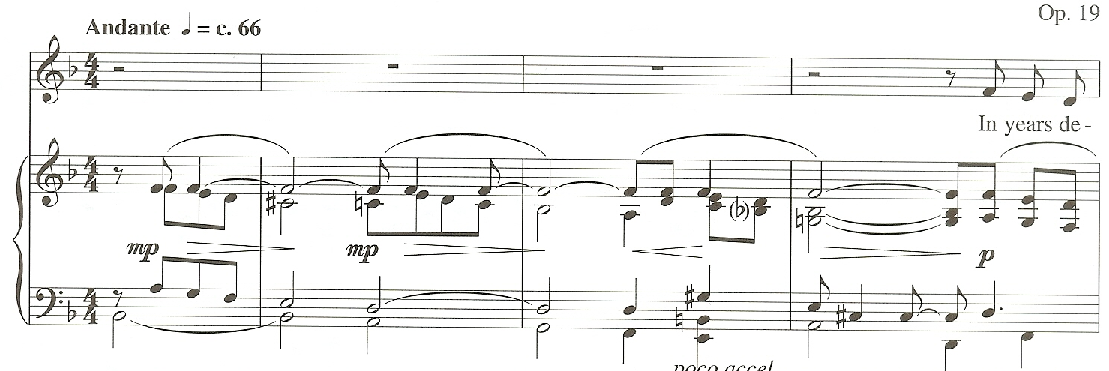
"The grievous mood of the introduction depicts the character's feelings as he views the spot where he once spent time with a love who has since died. The scene holds no trace of their presence now, but the essence of their love shall never be matched again. Finzi's writing here varies between a more characteristic style and some more insistent devices. Such is the case with the accompaniment in measures 8 through 9. The pedal point here is used to intensify the mood and is focused by dissonance and his use of appoggiaturas with a strong semi-tonal 6-5 figure (musical Example 18)."
(Denning, 76-7)
"Example 18: In Years Defaced, Measures 8-9." (Denning, 77) |

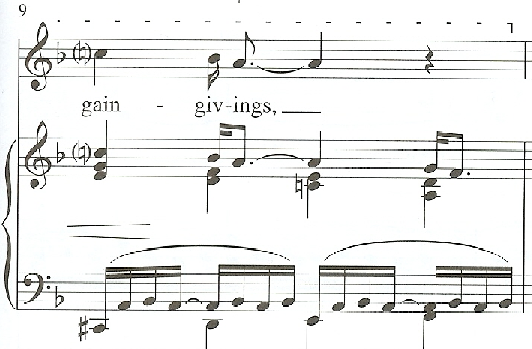
"This device is used within a second verse of the song as Finzi depicts Hardy's discussion of the 'gust and gales' which have been a part of the history of this spot (musical Example 19)."
(Denning, 77)
"Example 19: In Years Defaced, Measures 22-24." |
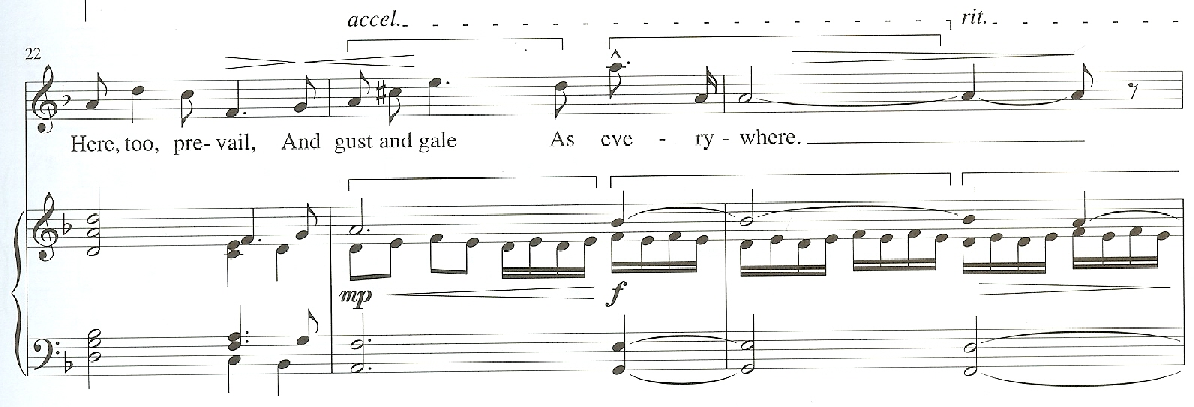
"Hardy's text for the closing of his poem is most touching, and Finzi has reacted admirably as both men depict a mystical scene where wandering souls feel a faint suggestion of the great love once shared there. Perhaps one of Finzi's most moving moments is the pianissimo ending of the vocal line achieved by the simple but effective use of a 9-8 and 4-3 accented passing tones. It is fitting that this section provides a name for the entire set (musical Example 20)."
(Denning, 78)
"Example 20: In Years Defaced, Measures 32-33." (Denning, 78) |
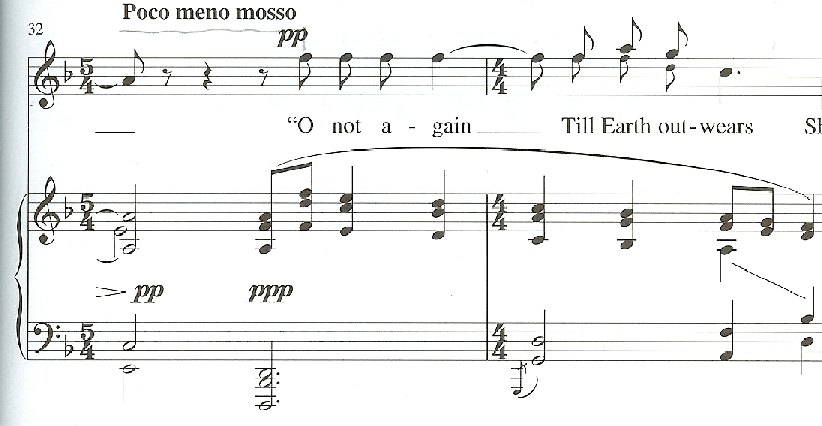
"Though the composer has indicated that this last verse should begin in the original tempo, it seems more appropriate to allow both pianist and singer more liberty to achieve every nuance possible without overshadowing the effect of the last phrase which fades to nothing."
(Denning, 78)

